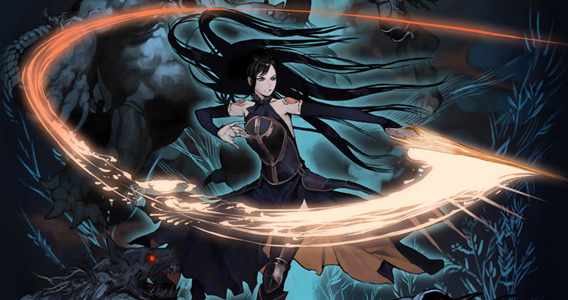
When Koji Igarashi appears with that iconic whip on his hip, he wants us to believe that he IS Castlevania. But considering how the series has developed through recent handheld iterations, I often wondered why he would want to perpetuate that idea. And then when I initially heard that Order of Ecclesia would be radically different BECAUSE you play as a female character, I wondered if I should get back to that novel I’ve been working on from time to time.
I wasn’t alone in my early disinterest, which may well serve as Konami’s theme for 2008. But finally taking the time to play Ecclesia, I’ve discovered an immense void between what Konami PR focuses on and what the game actually achieves. Perhaps games can’t be properly explained with words. Perhaps developers do a poor job explaining their creations, having worked in the absence of a journalism that presses for the rationale behind creative decisions. [Honestly, can you believe no one questions these statements?] BUT, as a favor to Konami, for a nominal charge, I present the following marketing assistance;
Order of Ecclesia is a glorious Bitch-Goddess.
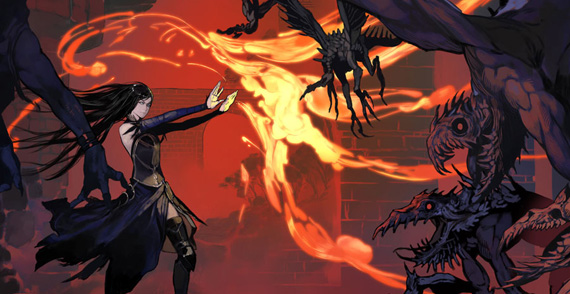
The truth of that re-branding isn’t immediately obvious. You’ll have to slug past a tutorial of skeletons, verifying that you’ve pressed buttons at least once in your life. You’ll also need to skip through several dialogue boxes that stand between you, thin narrative, and the game proper. And then like any good religious experience or sexual awakening, the truth will suddenly hit you. When it does, you’ll likely be standing at the edge of one screen, weighing your dwindling health meter against the giant Frankenstein waiting to stomp your corpse on the next screen. Then you’ll likely savior a serious attempt to return Castlevania to form.
In order for this generalization to be true, there MUST be some series of incredibly epic [The word EPIC will only be used once during this review] boss encounters.
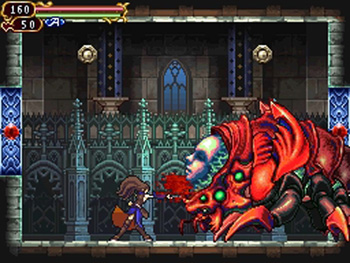
The first attempt at achieving this takes place within a monastery. A large crab creature waits patiently in the final chamber. As it crawls forward, it reveals itself as some aborted throwback from a lost Contra level, scrapped from Konami’s cutting-room floor. As proof of its origins, a section of its shell peels back, revealing the web-spitting face of a child. The creature doesn’t put up much of a fight, the player able to simply hang overhead to avoid its lazy attacks. Knowing that it isn’t fit to live, the creature wishes to die, and waits for the player to drop down and end its suffering. Locked into this obligatory battle, the creature works with the player to tie the stage together and end the anti-climatic moment quickly. But this is an initial deception, hiding the truth of what’s to follow.
Defeating that creature opens a path toward an island prison. And feeling suddenly invincible, I charged into this stage only to be caught by a spotlight that awoke a giant skeleton. As it slowly lurched toward me, I saw an opportunity to again hang overhead, dodging the first attacks and quickly stabbing back. But then without warning, the skeleton leaped into an airborne body-slam. I was suddenly knocked to the ground, watching as it grabbed Shanoa in one hand and beat her senseless with the other. I sat up in my chair, gripping the DS tighter in disbelief at the idea that she was dead. It seemed unthinkable, and I had to lean forward and make three more attempts before surviving the encounter.
This unforeseen difficulty fluctuated wildly with each battle that followed. I fought a floating, tentacle-spewing skull with little effort, only to later have a water demon kill me seven times in ten minutes. And I started to think that the tiny DS cartridge was mocking me. It knows that I’ve become a lazy gamer, too comfortable with being able to simply strike at enemies, taking damage but knowing that I’ll survive long enough to win. Ecclesia knows this about me, and wakes me from that daydream by spitting in my face, because this game simply won’t tolerate that attitude. Yet it finds humor in exposing my habits, seemingly feeding them with stages requiring little effort, only to then beat me to a pulp during the next. In the end, the only way to prevail is to learn the mechanics, using every button available to strike-dodge-strike-flip-strike again.
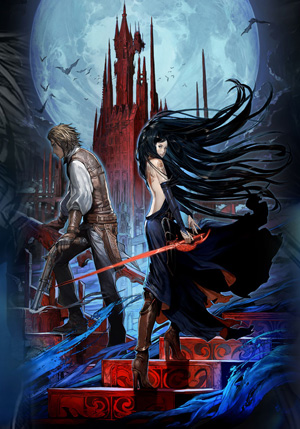
After a long, hard winter, Order of Ecclesia FEELS like a Castlevania game. I know this because when my girlfriend tries to tell me about her day, I interrupt and tell her that a giant spider-crab repeatedly knocked the crap out of me. I know this because I keep turning the DS off in frustration, only to fidget for two minutes and then turn the game on again. I tell myself I just need to put more effort into the battle. And slowly, the impulses that kept me inside on sunny days as a child resurface. I just need to try a little harder, and then I can feel the satisfaction of using an elevator to crush that giant spider-crab into pulp. Then I can start the next stage, and have the frustration start all over again.
Rather than one enormous castle, stages are broken apart and revealed via a world map. Breaking the game into smaller sections simplifies the OCD 100% exploration nature of Castlevania. Additionally, if any level proves difficult, players can escape to the map with a magical ticket and return to the village, which acts as a safe haven and supply base. But the icing that could have been is in imagining the possibilities of a world map that doesn’t simply list locations to be clicked on and thus warped to. The Adventure of Link weighs heavy on my mind as a template for the type of world map system that would best compliment Castlevania. Traveling across such a map might finally deepen the types of side-quests and exploration that the series leans toward, but never commits to.
That village is initially vacant by the way, because its inhabitants are being held throughout the stages, waiting to be rescued. In a peculiar nod to the times, their gratitude is short lived. They charge you for their services, whether it’s new armor or a fashionable dress. I suppose everyone has to make a living, but these villagers also burden the player with side-quests to gather the supplies they need for their trade. Though the idea is to extend game-play, most of the items requested are accidentally acquired with little effort during a first play-through. What’s far more interesting is the fact that you can also save the villager’s cats. Yes, in Order of Ecclesia you can save cats. That’s the most beautiful sentence I’ll likely write this year. What mad genius decided that players should save cats? And should Shanoa, accidentally of course, strike at these cats, they hiss and raise their fur in her direction. This attention to an utterly random detail is also why Ecclesia FEELS like a Castlevania game.
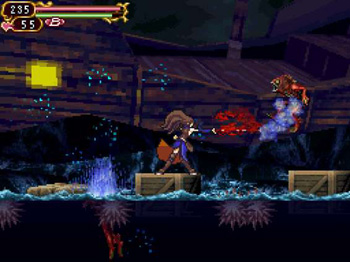
The utter charm of intimate design extends beyond those cats to furnish the series and this release with the most personable monstrosities of any game. Many of these creatures are old staples of the series, returned to Ecclesia because they continue to offer a REAL depth and mastery of character design. Creatures both frustrate and delight with unique manoeuvres and attacks that require a constant reordering of weapons to combat them.
As with recent entries, Ecclesia still requires a gimmick for its attack system, the series still unwilling to fully embrace the simple bliss of pure combat. Ecclesia uses a “Glyph” system, where a glyph represents a weapon or spell. The numerous glyphs discovered can be assigned to any one of three buttons on the DS. A strategy forcible emerges as glyphs drain the player’s MP, which does regenerate with time but makes missed strikes a deadly mistake. Enemies still provide random weapon drops when defeated, though the word “random” is replaced herein with the word “likely”. The most interesting trickery is in using the glyph system to steal a spell while an enemy attempts to cast it.
Order of Ecclesia embraces the possibilities of design that often make 2D titles visually superior to 3D offerings. Exploding brains, wailing character deaths, and giant skeletons crushed and splintered by their own axes are a feast for the retina – dessert served to your ears via a soundtrack that proves again to the industry that a Castlevania soundtrack is often unmatched. While many have been marveling over the return of an 8-bit Mega Man, playing Ecclesia has me wondering about the possibilities of pushing 2D design further still. Whether daydreaming or musing, I’m increasingly curious of what would come from the marriage of Vanillaware’s lush palettes with the viciously addictive game-play of Castlevania?